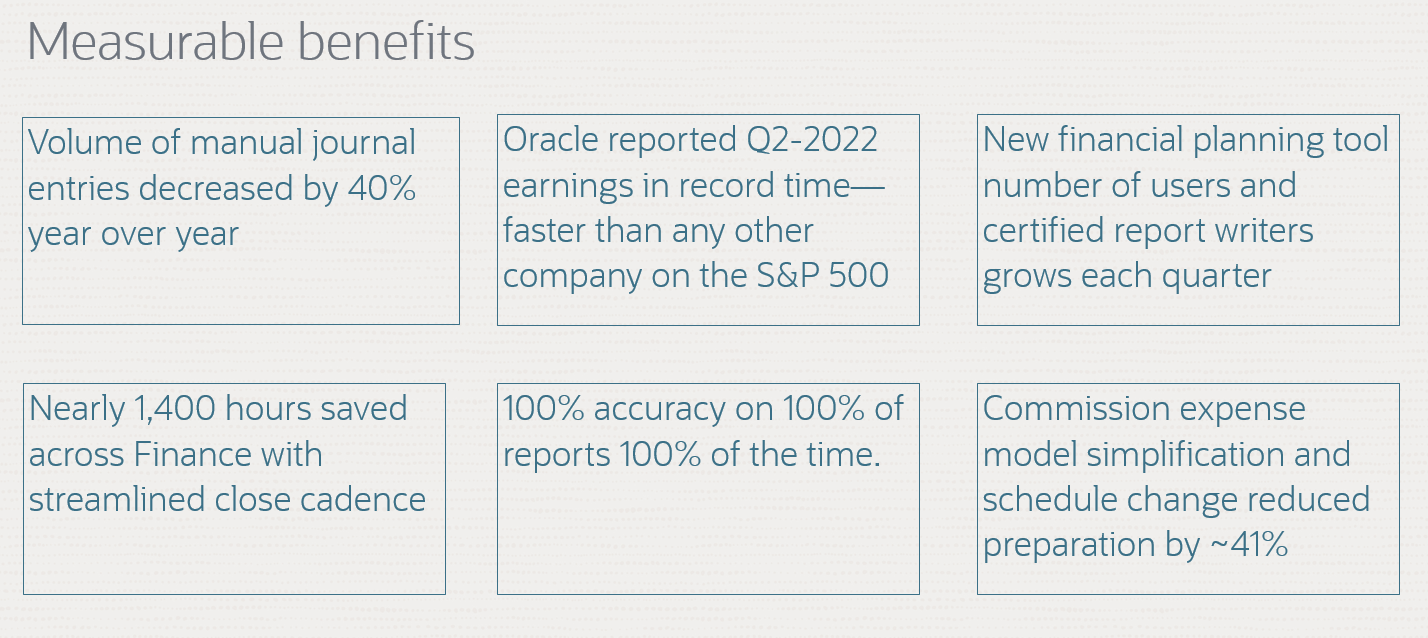Measure Success
Every company will have its own specific metrics for measuring success.
To measure the success of the CoE, review Define Your Goals and measure KPIs that link to these goals.
In addition, review the Value of EPM ebook to see the typical success that companies receive after implementing EPM Cloud. Sample metrics might include:
- Overall benefits:
- Improved collaboration and communication, upgrading remote-work processes
- Lower cost of ownership due to reduced technical debt
- Rapid access to EPM innovation, accelerating digital transformation initiatives
- Increased automation and best practices, allowing more time to focus on what matters
- Increased adoption of emerging technology like AI and ML
- Easily meet rising ESG demands
- Better planning:
- Increased flexibility of planning and forecasting processes
- Reduction in the number of days to plan per cycle
- Reduction in time for data gathering
- Less time spent preparing monthly forecasting
- Fewer days spent on annual planning
- Greater visibility into planning and forecasting activities
- Greater alignment between lines of business
- More likely to connect supply chain planning and integrated business planning
- Increased forecast accuracy
- More time spent on analysis
- More time spent on taking action
- A faster, complete close with cloud capabilities:
- Drop in the use of spreadsheets for intercompany eliminations
- Drop in the user of spreadsheets for transaction matching
- Reduction in days to close per cycle
- Saved time and gained agility
- Less time spent to produce management reporting
- Improved transparency for increased audit effectiveness
- More flexible reporting tools for improved user based reporting and analysis
- Best practice capabilities for improved process efficiency
- Improved account reconciliation in the cloud:
- Improved efficiency through transaction matching and automation
- Reduced auditing time
- Improved efficiency
- Eliminated tasks and reduced costs
- Reported fewer manual adjustments
- Improved financial reporting flexibility
- Gained visibility and tracking across the extended close
- Improvements in tax, reporting, and cost management:
- Greater effectiveness to implement tax strategies
- Improved automation of transfer pricing and compliance
- Improved data transparency of transfer pricing
- Reduced time to define, produce, and deliver financial close reports, including regulatory filings and annual reports
- Improved security so that the most important and confidential data is visible only to authorized users
- Ability to obtain the most accurate picture possible through collaboration and accurate numbers
- Ability to track progress and status of reporting through all phases
- Improvements at the company level:
- Improved ability to meet company goals
- Improved speed of innovation
- Number of initiatives, improvements, or projects
- Reduction in customer support issues
- Improvement in employee morale and engagement, for example, as measured by feedback on internal surveys
- Return on Investment (ROI)
- Environmental, social, and governance (ESG) sustainability:
- EPM can run with 0.0 carbon footprint (market-based).
- To find out more about the Oracle data centers that run on 100% renewable energy, see Clean Cloud OCI (Gen2) Data Sheet, RE% column.
Learn how Oracle Enterprise Data Management (EDM) is helping customers transform their businesses faster, whether it’s facilitating faster M&A integration or simplifying their chart of accounts.
Adopting Oracle Cloud EPM with the support of a CoE shows additional, considerable benefits. Here is one example. For more, please review the Oracle@Oracle stories and our customer stories.
